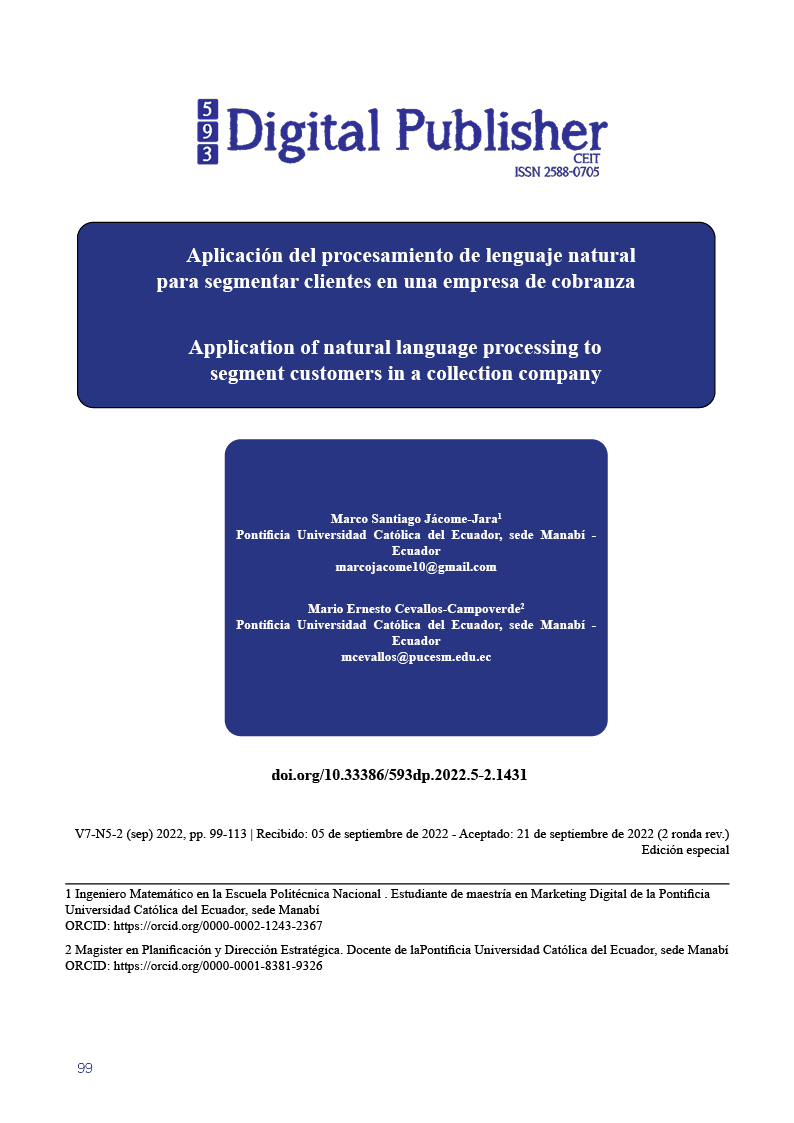Application of natural language processing to segment clients in a collection company.
Main Article Content
Abstract
Portfolio collecting is highly demanded activity, driven by financial inclusion, digital transformation and data science. Collection companies invest in infrastructure and labour to be competitive and profitable, in a market swayed by significant economic and social changes.
Traditional marketing uses hard variables in order to get knowledge of the structure, characteristics and conditions from groups or individuals, the inclusion of soft variables to this process adds the formerly concelaled information, improving the analysis. Within this line, according to transactional analysis, there are three different ways from where and to where we relate to the world: parent, adult and child.
The behaviors, thoughts, feelings, and emotions that are expressed in each of these states are called "ego states." The use of these tools at a business level is favored by the evolution of neuromarketing and the development of computational techniques to synthesize cognitive processes, these are called Artificial Intelligence (AI).
Thus, this research hyphotesis proposes to answer whether the a priori identification of the ego states allows to differentiate the parent, adult and child relationship patterns, using AI, and suggests to use these soft variables for segmentation of past due portfolio.
Using Python for Natural Language Processing (NLP) and logistic regression to clarify the relationships between segmentation and payment behavior. The results obtained revealed the existence of such patterns and their acceptance throughly, additionally they put forward the bases for the design of effective strategies in modern collection management.
Key words: customer segmentation, debt collection, soft variables, buyer persona, artificial intelligence
Downloads
Article Details

This work is licensed under a Creative Commons Attribution-NonCommercial-ShareAlike 4.0 International License.
1. Derechos de autor
Las obras que se publican en 593 Digital Publisher CEIT están sujetas a los siguientes términos:
1.1. 593 Digital Publisher CEIT, conserva los derechos patrimoniales (copyright) de las obras publicadas, favorece y permite la reutilización de las mismas bajo la licencia Licencia Creative Commons 4.0 de Reconocimiento-NoComercial-CompartirIgual 4.0, por lo cual se pueden copiar, usar, difundir, transmitir y exponer públicamente, siempre que:
1.1.a. Se cite la autoría y fuente original de su publicación (revista, editorial, URL).
1.1.b. No se usen para fines comerciales u onerosos.
1.1.c. Se mencione la existencia y especificaciones de esta licencia de uso.
References
Acevedo, E. (2018). Según el Global Findex y más allá del Global Findex. https://www.findevgateway.org/sites/default/files/publications/files/libro_inclusion-versiondigital_0.pdf
Antonio, F., & Zaga, R. (2021). El sobreendeudamiento como problema legal y social. Propuesta de reforma del Código de Protección y Defensa del Consumidor. https://doi.org/10.21142/DES-1301-2021-0011
Arias, E. (2 de enero de 2022). Historia del crédito. https://economipedia.com/historia/historia-del-credito.html
Armstrong, G., Kotler, P., y Mues Zepeda, A. (2013). Fundamentos de marketing. https://frrq.cvg.utn.edu.ar/pluginfile.php/14584/mod_resource/content/1/Fundamentos%20del%20Marketing-Kotler.pdf
Arroyo, I. (2021). Universidad Andina Simón Bolívar Sede Ecuador. Modelo econométrico aplicado para determinar el comportamiento de la cartera de microcrédito de los bancos privados del Ecuador especializados en microcrédito en el periodo 2007-2019. http://hdl.handle.net/10644/8384
Banco Mundial. (29 de marzo de 2022). Inclusión financiera. Entendiendo La Pobreza. https://www.bancomundial.org/es/understanding-poverty
Bojanić, M., Delić, V., & Karpov, A. (2020). Call redistribution for a call center based on speech emotion recognition. Applied Sciences (Switzerland), 10(13). https://doi.org/10.3390/app10134653
Caldentey, E. P., & Titelman, D. (2014). La inclusión financiera para la inserción productiva y el papel de la banca de desarrollo. www.cepal.org/es/suscripciones
Cambria, E., Havasi, C., & Hussain, A. (2012). SenticNet 2: A Semantic and Affective Resource for Opinion Mining and Sentiment Analysis. www.aaai.org
Contact Center Predictions for 2023 and Beyond. (2022). 8x8 Contact Center Predictions Report. https://www.8x8.com/resources?asset=97g7vnr0v375h8nqg0tafm7fah
Demirgüç-Kunt, A., Klapper, L., Singer, D., & Ansar, S. (2021). Financial Inclusion, Digital Payments, and Resilience in the Age of COVID-19.
Demirguc-Kunt, A., Klapper, L., Singer, D., Ansar, S., Hess, J. (2018) A. The Global Findex Banco Mundial. (2017). The Global Findex Database 2017 Measuring Financial Inclusion and the Fintech Revolution. https://documentos.bancomundial.org/es/publication/documents-reports/documentdetail/332881525873182837/the-global-findex-database-2017-measuring-financial-inclusion-and-the-fintech-revolution
Fabricio, R., & Flores, D. (2018). Determinantes de la Tasa de Morosidad de la Cartera Bruta de Consumo: Desde la visión de los datos de panel dinámicos. https://estadisticas.superbancos.gob.ec/portalestadistico/portalestudios/wp-content/uploads/sites/4/downloads/2018/09/determinantes_morosidad_2017.pdf
Felipe, D., Espinoza, V., Jesús, J., & Julissa, M. (2021). Inteligencia artificial y condición humana: ¿Entidades contrapuestas o fuerzas complementarias? https://www.redalyc.org/articulo.oa?id=28066593034
Golman, M., & Bekerman, M. (2018). What drives debt defaults in microfinance? The case of the asociación civil avanzar. In Problemas del Desarrollo (Vol. 49, Issue 195, pp. 127–151). Universidad Nacional Autónoma de México. https://doi.org/10.22201/iiec.20078951e.2018.195.62527
Improving Debt Collection with Technology. (Diciembre de 2022). Https://www.Acqueon.Com/Blog/Improving-Debt-Collection-with-Technology/.
Jácome, M. (2015). Construcción de un modelo estadístico para calcular el riesgo de deterioro de una cartera de microcréditos y propuesta de un sistema de gestión para la recuperación de la cartera en una empresa de cobranzas. http://bibdigital.epn.edu.ec/handle/15000/9194
Peña, O. (2019). Análisis de audio para extracción de características, segmentación, clasificación y predicción https://cimat.repositorioinstitucional.mx/jspui/bitstream/1008/1029/1/TE%20754.pdf
Rivera, M., Pulgar, K., Dávalos, E., y Gallegos, D. (2022). Inclusión financiera y pobreza: Un analisis para el Ecuador. www.cidecuador.com
Solano, R., Guerrero, R., y Ponce, K. (2020). Inclusión financiera y desarrollo. https://www.superbancos.gob.ec/bancos/wp-content/uploads/downloads/2020/07/LIBRO-INCLUSION-FINANCIERA-Y-DESARROLLO.pdf



